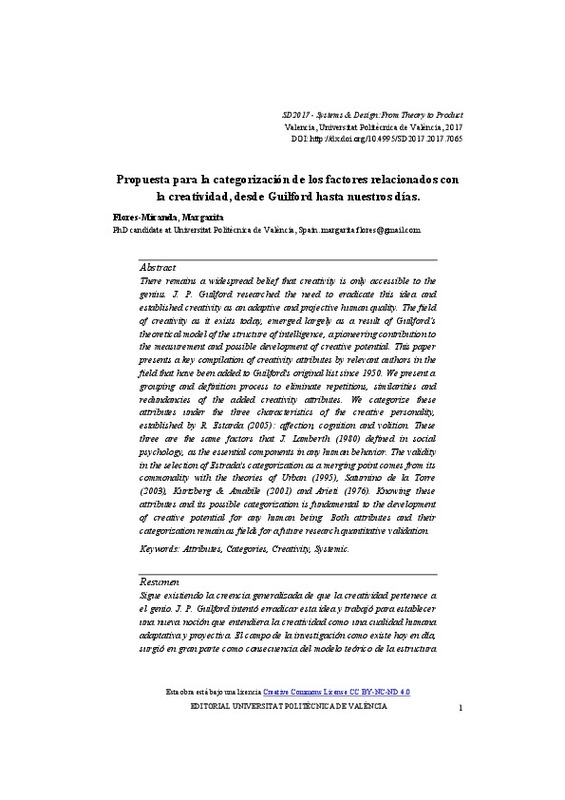JavaScript is disabled for your browser. Some features of this site may not work without it.
Buscar en RiuNet
Listar
Mi cuenta
Estadísticas
Ayuda RiuNet
Admin. UPV
Propuesta para la categorización de los factores relacionados con la creatividad, desde Guilford hasta nuestros días
Mostrar el registro sencillo del ítem
Ficheros en el ítem
| dc.contributor.author | Flores Miranda, Margarita
|
es_ES |
| dc.date.accessioned | 2018-06-06T07:48:18Z | |
| dc.date.available | 2018-06-06T07:48:18Z | |
| dc.date.issued | 2017-11-30 | |
| dc.identifier.isbn | 9788490485828 | |
| dc.identifier.uri | http://hdl.handle.net/10251/103429 | |
| dc.description.abstract | [EN] This study investigated what it meant and continues to mean for the creativity scientific field, J. P. Guilford´s research on the need to eradicate genius theory in order to give rise to the idea of creativity as an adaptive and projective human quality. The field of creativity as it exists today, emerged largely as a result of Guilford´s theoretical model of the structure of intelligence, a pioneer contribution to the measurement and possible development of creative potential. To these days, Guilford´s and E. Paul Torrance´s (1962) factors related to creativity remain the most widely used in the design of creativity tests. This paper presents a complication of the creativity factors that have been added to Guilford's original list since 1950 until these days, by diverse and relevant authors in the field. A grouping process is performed to eliminate repetitions, similarities or redundancies, and to obtain a list of clearly differentiated attributes. Every attribute is defined in the creativity context in order to examine how they could be related under R. Estarda (2005) theory of creativity, that categorize creativity´s factors in the following triad: affection, cognition and volition. Same factors that J. Lamberth (1980) defined in social psychology, as the essential components in any measurement of behavior. The validity in the selection of Estrada's theory as a merging point comes from its commonality with the theories of Urban (1995), Saturnino de la Torre (2003), Kurtzberg & Amabile (2001) and Arieti (1976). This study supports the view of creativity as a systemic process that considers both the contextual and the individual contribution, and contemplates the potential interplay among the three behavioral components. Concluding that factors related to creativity play an essential role on the identification and the development of creative potential. Both attributes and their categorization remain as fields for a future research´s quantitative validation. | es_ES |
| dc.description.abstract | [ES] Sigue existiendo la creencia generalizada de que la creatividad pertenece a el genio. J. P. Guilford intentó erradicar esta idea y trabajó para establecer una nueva noción que entendiera la creatividad como una cualidad humana adaptativa y proyectiva. El campo de la investigación como existe hoy en día, surgió en gran parte como consecuencia del modelo teórico de la estructura de la inteligencia de Guilford, que constituyo una contribución pionera a la medición y posible desarrollo del potencial creativo. Este documento presenta una compilación de los atributos de la creatividad que los diversos autores relevantes a el campo han aportado al listado original de Guilford desde 1950. Presentamos el resultado del proceso de agrupación y definición que se realizo con el objetivo de eliminar, repeticiones, similitudes ó redundancias en los atributos agregados. Categorizamos estos atributos de acuerdo a los tres aspectos de la personalidad creativa de R. Estrada (1985): cognitivos, afectivos y volitivos. Estos tres son los mismos factores que J. Lamberth (1980) define desde la psicología, como los componentes esenciales a cualquier comportamiento humano. La validez en la selección de la categorización de Estrada, proviene de su similitud con las teorías de la Creatividad de Urban (1995), Saturnino de la Torre (2003), Kurtzberg & Amabile (2001) y Arieti (1976). Conocer estos atributos y su posible categorización es fundamental en el desarrollo del potencial creativo de cualquier persona. Tanto los atributos como su categorización permanecen abiertos a una futura investigación cuantitativa que certifique su validez. | es_ES |
| dc.format.extent | 16 | es_ES |
| dc.language | Inglés | es_ES |
| dc.publisher | Editorial Universitat Politècnica de València | es_ES |
| dc.relation.ispartof | Systems & Design: From Theory to Product | es_ES |
| dc.rights | Reconocimiento - No comercial - Sin obra derivada (by-nc-nd) | es_ES |
| dc.subject | Atributos | es_ES |
| dc.subject | Categorías | es_ES |
| dc.subject | Creatividad | es_ES |
| dc.subject | Sistémico | es_ES |
| dc.subject | Attributes | es_ES |
| dc.subject | Categories | es_ES |
| dc.subject | Creativity | es_ES |
| dc.subject | Systemic | es_ES |
| dc.title | Propuesta para la categorización de los factores relacionados con la creatividad, desde Guilford hasta nuestros días | es_ES |
| dc.title.alternative | Proposal for the categorization of the factors related to creativity, from Guilford to these days. | es_ES |
| dc.type | Capítulo de libro | es_ES |
| dc.type | Comunicación en congreso | es_ES |
| dc.identifier.doi | 10.4995/SD2017.2017.7065 | |
| dc.rights.accessRights | Abierto | es_ES |
| dc.description.bibliographicCitation | Flores Miranda, M. (2017). Propuesta para la categorización de los factores relacionados con la creatividad, desde Guilford hasta nuestros días. En Systems & Design: From Theory to Product. Editorial Universitat Politècnica de València. 1-16. https://doi.org/10.4995/SD2017.2017.7065 | es_ES |
| dc.description.accrualMethod | OCS | es_ES |
| dc.relation.conferencename | Systems & Design 2017 | es_ES |
| dc.relation.conferencedate | November 30-30,2017 | es_ES |
| dc.relation.conferenceplace | Valencia, Spain | es_ES |
| dc.relation.publisherversion | http://ocs.editorial.upv.es/index.php/SD/SD2017/paper/view/7065 | es_ES |
| dc.description.upvformatpinicio | 1 | es_ES |
| dc.description.upvformatpfin | 16 | es_ES |
| dc.type.version | info:eu-repo/semantics/publishedVersion | es_ES |
| dc.relation.pasarela | OCS\7065 | es_ES |








